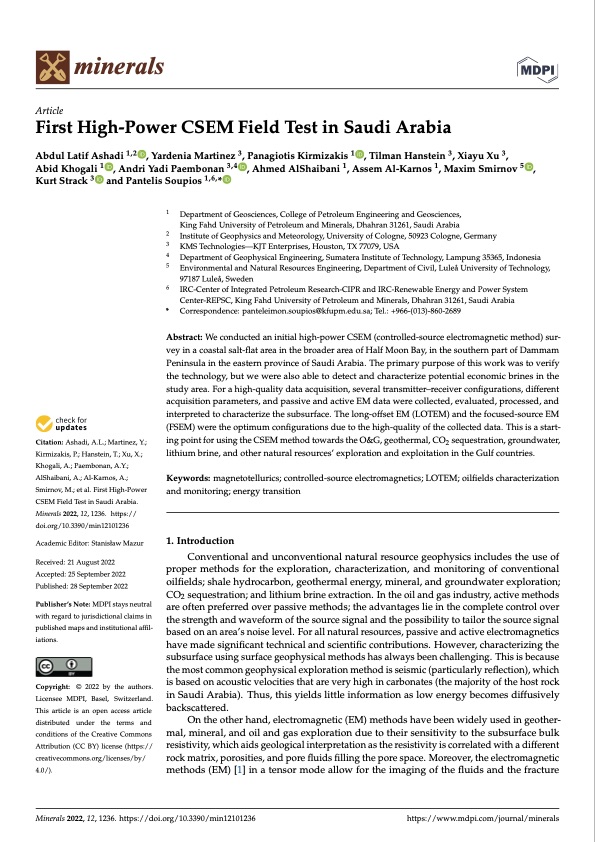
PDF Publication Title:
Text from PDF Page: 001
minerals Article First High-Power CSEM Field Test in Saudi Arabia Abdul Latif Ashadi 1,2 , Yardenia Martinez 3, Panagiotis Kirmizakis 1 , Tilman Hanstein 3, Xiayu Xu 3, Abid Khogali 1 Kurt Strack 3 , Andri Yadi Paembonan 3,4 , Ahmed AlShaibani 1, Assem Al-Karnos 1, Maxim Smirnov 5 , and Pantelis Soupios 1,6,* 1 2 3 4 5 6 * Correspondence: panteleimon.soupios@kfupm.edu.sa; Tel.: +966-(013)-860-2689 Abstract: We conducted an initial high-power CSEM (controlled-source electromagnetic method) sur- vey in a coastal salt-flat area in the broader area of Half Moon Bay, in the southern part of Dammam Peninsula in the eastern province of Saudi Arabia. The primary purpose of this work was to verify the technology, but we were also able to detect and characterize potential economic brines in the study area. For a high-quality data acquisition, several transmitter–receiver configurations, different acquisition parameters, and passive and active EM data were collected, evaluated, processed, and interpreted to characterize the subsurface. The long-offset EM (LOTEM) and the focused-source EM (FSEM) were the optimum configurations due to the high-quality of the collected data. This is a start- ing point for using the CSEM method towards the O&G, geothermal, CO2 sequestration, groundwater, lithium brine, and other natural resources’ exploration and exploitation in the Gulf countries. Keywords: magnetotellurics; controlled-source electromagnetics; LOTEM; oilfields characterization and monitoring; energy transition 1. Introduction Conventional and unconventional natural resource geophysics includes the use of proper methods for the exploration, characterization, and monitoring of conventional oilfields; shale hydrocarbon, geothermal energy, mineral, and groundwater exploration; CO2 sequestration; and lithium brine extraction. In the oil and gas industry, active methods are often preferred over passive methods; the advantages lie in the complete control over the strength and waveform of the source signal and the possibility to tailor the source signal based on an area’s noise level. For all natural resources, passive and active electromagnetics have made significant technical and scientific contributions. However, characterizing the subsurface using surface geophysical methods has always been challenging. This is because the most common geophysical exploration method is seismic (particularly reflection), which is based on acoustic velocities that are very high in carbonates (the majority of the host rock in Saudi Arabia). Thus, this yields little information as low energy becomes diffusively backscattered. On the other hand, electromagnetic (EM) methods have been widely used in geother- mal, mineral, and oil and gas exploration due to their sensitivity to the subsurface bulk resistivity, which aids geological interpretation as the resistivity is correlated with a different rock matrix, porosities, and pore fluids filling the pore space. Moreover, the electromagnetic methods (EM) [1] in a tensor mode allow for the imaging of the fluids and the fracture Department of Geosciences, College of Petroleum Engineering and Geosciences, King Fahd University of Petroleum and Minerals, Dhahran 31261, Saudi Arabia Institute of Geophysics and Meteorology, University of Cologne, 50923 Cologne, Germany KMS Technologies—KJT Enterprises, Houston, TX 77079, USA Department of Geophysical Engineering, Sumatera Institute of Technology, Lampung 35365, Indonesia Environmental and Natural Resources Engineering, Department of Civil, Luleå University of Technology, 97187 Luleå, Sweden IRC-Center of Integrated Petroleum Research-CIPR and IRC-Renewable Energy and Power System Center-REPSC, King Fahd University of Petroleum and Minerals, Dhahran 31261, Saudi Arabia Citation: Ashadi, A.L.; Martinez, Y.; Kirmizakis, P.; Hanstein, T.; Xu, X.; Khogali, A.; Paembonan, A.Y.; AlShaibani, A.; Al-Karnos, A.; Smirnov, M.; et al. First High-Power CSEM Field Test in Saudi Arabia. Minerals2022,12,1236. https:// doi.org/10.3390/min12101236 Academic Editor: Stanisław Mazur Received: 21 August 2022 Accepted: 25 September 2022 Published: 28 September 2022 Publisher’s Note: MDPI stays neutral with regard to jurisdictional claims in published maps and institutional affil- iations. Copyright: © 2022 by the authors. Licensee MDPI, Basel, Switzerland. This article is an open access article distributed under the terms and conditions of the Creative Commons Attribution (CC BY) license (https:// creativecommons.org/licenses/by/ 4.0/). Minerals 2022, 12, 1236. https://doi.org/10.3390/min12101236 https://www.mdpi.com/journal/mineralsPDF Image | First High-Power CSEM

PDF Search Title:
First High-Power CSEMOriginal File Name Searched:
minerals-12-01236-v2.pdfDIY PDF Search: Google It | Yahoo | Bing
Product and Development Focus for Infinity Turbine
ORC Waste Heat Turbine and ORC System Build Plans: All turbine plans are $10,000 each. This allows you to build a system and then consider licensing for production after you have completed and tested a unit.Redox Flow Battery Technology: With the advent of the new USA tax credits for producing and selling batteries ($35/kW) we are focussing on a simple flow battery using shipping containers as the modular electrolyte storage units with tax credits up to $140,000 per system. Our main focus is on the salt battery. This battery can be used for both thermal and electrical storage applications. We call it the Cogeneration Battery or Cogen Battery. One project is converting salt (brine) based water conditioners to simultaneously produce power. In addition, there are many opportunities to extract Lithium from brine (salt lakes, groundwater, and producer water).Salt water or brine are huge sources for lithium. Most of the worlds lithium is acquired from a brine source. It's even in seawater in a low concentration. Brine is also a byproduct of huge powerplants, which can now use that as an electrolyte and a huge flow battery (which allows storage at the source).We welcome any business and equipment inquiries, as well as licensing our turbines for manufacturing.| CONTACT TEL: 608-238-6001 Email: greg@infinityturbine.com | RSS | AMP |